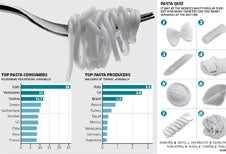Pasta has rolled out from Rome after centuries of being a staple in Italy to conquer plates and bowls as the world's favourite food.
Click HERE to view graphic (102k jpg)
A global survey by Oxfam places pasta ahead of meat, rice and pizza as it becomes popular in countries as diverse as the Philippines, Guatemala, Brazil and South Africa.
Italy remains the nation with the biggest appetite for pasta, ahead of Venezuela. Mexico, Switzerland, Greece and Bolivia all consume more per capita than Britain, according to the International Pasta Organisation.
It is a global love affair reflected in sales, which have risen from $13bn (£8bn) in 2003 to $16bn in 2010.
With variations and specialities for every Italian region, there are about 600 recognised varieties of the durum wheat-based staple, with conchiglie (shells) and farfalle (bow ties) among the more popular exports.
The Romans ate dishes a little like pasta, although they were baked and not boiled. The Chinese were eating noodles made of millet as long ago as 2000BC. There is a legend that the Venetian explorer Marco Polo returned to Italy in 1295 with the nation's first pasta, but it is not true. It was military defeat that brought it to the Italians.
Arab invaders from what is now Libya conquered Sicily in the eighth century, helped by bellies full of slow-release carbohydrates from a dried-noodle product they brought with them. It was made from durum wheat. Under current Italian law, all dry pasta made there – most of the world's pasta – must be made from this.
Italians made two crucial additions to pasta that turned it into the dish now loved more than any other. First, by using durum wheat with a high gluten content their pasta was especially malleable, hence the variety of shapes and sizes. Second, they also combined it with sauce that was made from the other southern-Italian specialty, the tomato.
In historically poor and pre-industrial southern Italy, its popularity was in no small part down to its cheapness. Pasta only came to take over the world when poor Italians ventured to the new world for a better quality of life and found that those they encountered were rather enamoured with what they had brought with them.
There is some irony in that the pasta heartlands Italian migrants left behind – Sicily, Sardinia, the Amalfi Coast – are now the destinations of choice for the super rich. And they eat pasta just as happily as the poorest 19th-century Italians did.

Join our commenting forum
Join thought-provoking conversations, follow other Independent readers and see their replies
Comments